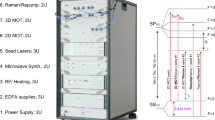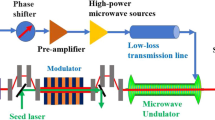Abstract
THIS communication describes preliminary measurements of the oscillation frequency of the Signals Research and Development Establishment Maser No. 5 at the National Physical Laboratory, Teddington (by the Standards Division), and afterwards at the Research Laboratories of the Australian Post Office in Melbourne, Australia. Maser No. 5 is a rack-mounted experimental maser with continuous pumping and employs unpurified commercial anhydrous ammonia. An eight-pole state separator is used together with a silver-plated brass microwave cavity operating in the TM 010 mode. The cavity is thermally tuned to the (3,3) transition. A more detailed description of this maser may be found elsewhere1.
This is a preview of subscription content, access via your institution
Access options
Subscribe to this journal
Receive 51 print issues and online access
$199.00 per year
only $3.90 per issue
Buy this article
- Purchase on Springer Link
- Instant access to full article PDF
Prices may be subject to local taxes which are calculated during checkout
Similar content being viewed by others
References
Mitchell, A. M. J., Roots, K. G., and Phillips, G., “Electronic Technology”, (to be published).
Barnes, F. S., Proc. Inst. Rad. Eng., 47, 2085 (1959).
Essen, L., and Parry, J. V. L., Trans. Roy. Soc., 250, 45 (1957).
Observatoire de Neuchâtel, Suisse, Circulaire No. 2 (May 1959).
Author information
Authors and Affiliations
Rights and permissions
About this article
Cite this article
MITCHELL, A., SANDBACH, E. Measurements of the Frequency of an Ammonia Maser in England and Australia. Nature 185, 833–834 (1960). https://doi.org/10.1038/185833a0
Issue Date:
DOI: https://doi.org/10.1038/185833a0
Comments
By submitting a comment you agree to abide by our Terms and Community Guidelines. If you find something abusive or that does not comply with our terms or guidelines please flag it as inappropriate.



